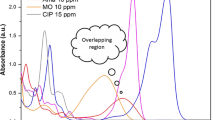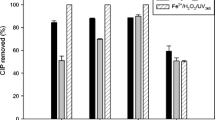Abstract
The study investigates the treatment of diclofenac (DCF), a pharmaceutical included in the first watch list of the European Water Framework Directive as a new potential priority substance in water. Since the conventional wastewater treatment technologies do not efficiently remove DCF, advanced treatment technologies capable of its complete removal or destruction of its biological activity, need to be evaluated and eventually employed. For that purpose, typical representatives of photooxidative and photocatalytic advanced oxidation processes were applied. The effectiveness of UV-C/H2O2 and UV-A/TiO2 were compared regarding DCF conversion and mineralization kinetics, water quality parameters for assessing biodegradability and toxicity. In spite of similar biodegradability profiles, the obtained results indicate different DCF degradation pathways, which are reflected in different profiles of toxicity towards Vibrio fischeri. The observed DCF conversion and mineralization kinetics revealed the benefits of UV-C/H2O2 process. However, lower toxicity favored the application of photocatalytic over photooxidative treatment for DCF removal.




Similar content being viewed by others
References
Kummerer K (2008) Pharmaceuticals in the environment; sources, fate, effects and risks. Springer, Heidelberg
Perez-Estrada LA, Malato S, Gernjak W, Aguera A, Thurman EM, Ferrer I, Fernandez-Alba AR (2005) Photo-Fenton degradation of diclofenac: identification of main intermediates and degradation pathway. Environ Sci Technol 39:8300–8306
Perez-Estrada LA, Maldonado MI, Gernjak W, Aguera A, Fernandez-Alba AR, Ballesteros MM, Malato S (2005) Decomposition of diclofenac by solar driven photocatalysis at pilot plant scale. Catal Today 101:219–226
Calza P, Sakkas VA, Medana C, Baiocchi C, Dimou A, Pelizzetti E, Albanis T (2006) Photocatalytic degradation study of diclofenac over aqueous TiO2 suspensions. Appl Catal B 67:197–205
Yu H, Nie E, Xu J, Yan S, Cooper WJ, Song W (2013) Degradation of diclofenac by advanced oxidation and reduction processes: kinetic studies, degradation pathways and toxicity assessments. Water Res 47:1909–1918
Manu B, Mahamood R (2012) Degradation kinetics of diclofenac in water by Fenton’s oxidation. J Sustain Energ Environ 3:173–176
Martín J, Camacho-Muñoz D, Santos JL, Aparicio I, Alonso E (2012) Occurrence of pharmaceutical compounds in wastewater and sludge from wastewater treatment plants: removal and ecotoxicological impact of wastewater discharges and sludge disposal. J Hazard Mater 239–240:40–47
Verlicchi P, Al Aukidy M, Zambello E (2012) Occurrence of pharmaceutical compounds in urban wastewater: removal, mass load and environmental risk after a secondary treatment—a review. Sci Total Environ 429:123–155
Tang WZ (2004) Physicochemical treatment of hazardous wastes. CRC Press, Lewis, Boca Raton
Beltran FJ (2003) Photocatalytic degradation of pollutants in water and air: basic concepts and applications. In: Tarr MA (ed) Chemical degradation methods for wastes and pollutants, environmental and industrial applications. Marcel Dekker, Inc, New York
Litter MI, Candal RJ, Meichtry JM (2014) Advanced oxidation technologies: sustainable solutions for environmental treatments. CRC Press, Taylor and Francis, London
Pichat P (2013) Photocatalysis and water purification: from fundamentals to recent applications. Wiley, Weinheim
Radanovic T, Brlenic V, Rembacz M, Juretic D, Kusic H, Lavrencic Stangar U, Loncaric Bozic A (2014) Degradation of diclofenac by photo-AOPs; photooxidation versus photocatalysis. Book of abstracts of 20th international conference on advanced oxidation technologies for treatment of water, air and soil, November 16–20, 2014, San Diego, p 135
Farré MJ, Franch MI, Ayllón JA, Peral J, Domènech X (2007) Biodegradability of treated aqueous solutions of biorecalcitrant pesticides by means of photocatalytic ozonation. Desalination 211:22–33
Clesceri LS, Greenberg AE, Eaton AD (1998) Standard methods for the examination of water and wastewater treatment, 20th edn. APHA & AWWA & WEF, Denver
EU, (2013) Directive 2013/39/EU of the European parliament and of the council amending directives 2000/60/EC and 2008/105/EC as regards priority substances in the field of water policy. Off J Eur Commun 226:1–17
Pichat P (2003) Photocatalytic degradation of pollutants in water and air: basic concepts and applications. In: Tarr MA (ed) Chemical degradation methods for wastes and pollutants, environmental and industrial applications. Marcel Dekker, Inc, New York
Juretic D, Kusic H, Dionysiou DD, Rasulev B, Loncaric Bozic A (2014) Modeling of photooxidative degradation of aromatics in water matrix; combination of mechanistic and structural-relationship approach. Chem Eng J 257:229–241
Gaya UI (2014) Heterogeneous photocatalysis using inorganic semiconductor solids. Springer, Heidelberg
Juretic D, Kusic H, Dionysiou DD, Loncaric Bozic A (2013) Environmental aspects of photooxidative treatment of phenolic compounds. J Hazard Mater 262:377–386
Kalinski I, Juretic D, Kusic H, Peternel I, Loncaric Bozic A (2014) Structural aspects of degradation of sulfoaromatics by UV/H2O2 process. J Photochem Photobiol A 293:1–11
Liu B, Zhao X (2014) Kinetic study of the heterogeneous photocatalysis of porous nanocrystalline TiO2 assemblies using a continuous random walk simulation. Phys Chem Chem Phys 16:22343–22351
Krebel M, Kušić H, Koprivanac N, Meixner J, Loncaric Bozic A (2011) Treatment of chlorophenols by UV-based processes: correlation of oxidation by-products, wastewater parameters and toxicity. J Environ Eng 137(7):639–649
Milovac N, Juretic D, Kusic H, Dermadi J, Loncaric Bozic A (2014) Photooxidative degradation of aromatic carboxylic acids in water; influence of hydroxyl substituents. Ind Eng Chem Res 53(26):10590–10598
Borja J, Taleon DM, Auresenia J, Gallardo S (2005) Polychlorinated biphenyls and their biodegradation. Process Biochem 40:1999–2013
Pulgarin C, Adler N, Peringer P, Comninellis C (1994) Electrochemical detoxification of 1,4-benzoquinone solution in wastewater treatment. Water Res 28(4):887–893
State Office for Waters (2001) Directive on amendments of regulations for limit values of hazardous substances and other indicators in wastewater. The Official Gazette 6 (January 24 2001)
EEC (1993) Commission directive 93/67/EEC of 20 July 1993 laying down the principles for the assessment of risks to man and the environment of substances notified in accordance with council directive 67/548/EEC. Off J Eur Commun 227:9–17
Calza P, Massolino C, Pelizzetti E (2008) Photo-induced transformation of hexaconazole and dimethomorph over TiO2 suspension. J Photochem Photobiol A 200:356–363
Calza P, Massolino C, Pelizzetti E, Minero C (2008) Solar driven production of toxic halogenated and nitroaromatic compounds in natural seawater. Sci Total Environ 398(1–3):196–202
Acknowledgments
We gratefully acknowledge the financial support from Croatian Science Foundation (Project No. UIP-2013-7900).
Author information
Authors and Affiliations
Corresponding author
Rights and permissions
About this article
Cite this article
Perisic, D.J., Kovacic, M., Kusic, H. et al. Comparative analysis of UV-C/H2O2 and UV-A/TiO2 processes for the degradation of diclofenac in water. Reac Kinet Mech Cat 118, 451–462 (2016). https://doi.org/10.1007/s11144-016-1027-4
Received:
Accepted:
Published:
Issue Date:
DOI: https://doi.org/10.1007/s11144-016-1027-4




